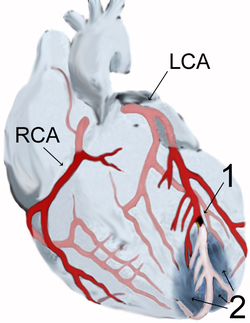Difference between revisions of "Myocardial infarction"
| Line 1: | Line 1: | ||
[[en:Myocardial infarction]] | [[en:Myocardial infarction]] | ||
[[ru:Инфаркт миокарда]] | [[ru:Инфаркт миокарда]] | ||
| − | [[File: | + | [[File:Myocardial_infarction.png|right]]<b>Myocardial infarction</b> is one of the clinical forms of [[ischaemic heart disease]] that occurs with the development of ischemic necrosis of the myocardium, caused by the absolute or relative insufficiency of its blood supply. |
==Classification== | ==Classification== | ||
By stages of development: | By stages of development: | ||
Revision as of 12:21, 7 June 2017
Myocardial infarction is one of the clinical forms of ischaemic heart disease that occurs with the development of ischemic necrosis of the myocardium, caused by the absolute or relative insufficiency of its blood supply.
Classification
By stages of development:
- The acutest period (up to 2 hours from the onset of myocardial infarction)
- Acute period (5-7 days from the onset of myocardial infarction)
- Subacute period (from 7 to 28 days)
- Period of scarring (from day 28)
By anatomy of lesions:
- Transmural
- Intramural
- Subendocardial
- Subepicardial
By the amount of damage:
- Large-focal (transmural), Q-infarction
- Small-focal, not Q-infarction
Localization of the focus of necrosis.
- Myocardial infarction of the left ventricle (anterior, lateral, inferior, posterior).
- Isolated myocardial infarction of the apex of the heart.
- Myocardial infarction of the interventricular septum (septal).
- Myocardial infarction of the right ventricle.
- Combined localization: posterior-inferior, anterior-lateral, etc.
By the nature of the current:
- Monocyclic current
- Protracted current
- Recurrent myocardial infarction
- Repeated myocardial infarction
It should be borne in mind that sometimes patients may have several types of myocardial infarction simultaneously or sequentially. It should be noted that the term "myocardial infarction" is not included in the concept of "necrosis of cardiomyocytes" due to сoronary artery bypass graft (opening in the ventricle, manipulations on the heart) and the influence of the following factors: renal and cardiac failure, pacing, electrophysiological ablation, sepsis, myocarditis, poisons of cardiotropic action, infiltrative diseases.

